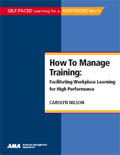How to Manage Training
Author: Carolyn NilsonPh.D
Credit: 2.0 CEUs
Testing Format: multiple choice
Your Price: $159.00
ISBN: 9780761214564
Format: Book
Overview
The knowledge, skills and guidance managers need to become true learning leaders.
Now more than ever, a versatile, well-trained workforce is critical to an organization’s success. Written for managers from a wide range of functional areas, this course gives any manager responsible for training the tools to help employees learn more, perform better, and work smarter. This comprehensive, up-to-date guide targets the roles necessary to manage training and learning in an organization: champion, builder, performance consultant, supporter, administrator, and keeper of the budget.
Filled with expert information and real-world scenarios, this new Self-Study course uses diagrams, charts, exercises, and a collection of tools for training delivery to help managers anticipate and solve a broad range of training challenges—for their own departments or for the entire organization.
How to Manage Training: Facilitating Workplace Learning for High Performancedelivers the knowledge, skills, and guidance managers need to become true learning leaders.
Course Objective: Develop the skills to manage training, facilitate workplace learning, and enhance organizational effectiveness.
Selected Learning Objectives
• Develop a sample business plan for training
• Deliver learning experiences in a wide range of formats
• Create programs for peer-to-peer assistance and collegial problem solving
• Foster coaching and mentoring in the workplace
• Promote learning and training opportunities at all levels in the organization
Testing Format
This course contains one multiple choice test valued at two Continuing Education Units (CEUs).
Table of Contents
About This Course
How to Take This Course
Pre-Test
1. Champion ofWorkplace Learning 1
Introduction
Jenn, the Office Manager
Characteristics of a Workplace that Values Learning
All Employees Have Access to Training
Both Formal and On-the-Job Learning Are Evident
Training Is Directly Related to Improving Job Knowledge and Skills
Establishing a Training and Learning Mission
Setting a Forward Direction
Defining Priorities
Stating Your Mission
Linking Training and Learning to Business Goals
Linking Training to Core Business Areas
Basics: The Four-Phase Training Process and the Three Categories of Learner Needs
The Business Plan for Training
Communicating the Training and Learning Message
Streamlining the Process: Workplace Models and Tips
External Promotion
Recap
Review Questions
2. Builder of a Learning Culture 35
Introduction
Precision Ball’s Stability Paradox
Planning and Implementing a Learning Strategy
Planning a Learning Strategy
Documenting the Plan
Making It Work for Individuals
Making It Work for Organizations
Leveraging the Power of Diversity
Creating Equal Opportunity for Learning
Building In Creativity and Innovation
Guidelines for Flexibility
Workforce Training for Creativity and Innovation
Above All, Get the Boss(es) Involved!
Encouraging On-the-Job Learning
The Computer and Learning
Coaching and Mentoring
Getting the Most Out of E-Learning
Techniques for Encouraging Self-Study
Team Learning
Understanding the Four-Phase Training Process
Phase 1: Assess
Phase 2: Design
Phase 3: Deliver
Phase 4: Evaluate
Management versus Development
Recap
Review Questions
3. Performance Consultant 73
Introduction
Defining the Gap Between What Should Be and What Is
The Agency’s “Vision Thing”
Working with Performance Standards
Performance and Ethics
Performance Standards for Processes
Performance Standards for Individuals
Focusing on Causes for Poor Performance
Focusing on Solution Interventions
Firming Up the Relationship between Performance and Training
When Training Is Not the Solution
Guidelines for Using Training as the Solution
Sharing the Performance Technology Model with Learners
Using Performance Standards to Facilitate Transfer of Training
Recap
Review Questions
4. Support 99
Introduction
One Supermarket’s Commitment to ADA
Facilities and Personnel Resources
Training and Learning Spaces
Equipment and Supplies
Print Materials
Presentation Materials
Professional and Support Personnel
Training the Trainer
Preparation
Executive as Presenter
Monitoring, Feedback, and Follow Up
Monitoring Performance
Giving, Receiving, and Using Feedback
Follow Up: Making Training Stick
Supporting Career Development
Recap
Review Questions
5. Administrator 125
Introduction
Administering Training that Mattered at Cybernautics
Serving a Changing Workforce
Facilitating Internal Networking for Learning
Balancing Training and Functional Responsibilities
Recruitment, Negotiation, Alignment of Goals
Places to Look for Maximum Impact
Guidelines for Going Outside
Getting the Most Value from Outside Seminars
Managing Per Diem Trainers
Learning Management Systems
Training Project Management
How to Assess Quality in Training Projects
Recap
Review Questions
6. Keeper of the Budget 141
Introduction
Who’s Your Boss?
Cost Center or Profit Center?
The Training Operation as a Cost Center
The Training Operation as a Profit Center
Budget and Accounting for Training and Learning
Productivity
Return on Investment
The Make or Buy Decision
The Request for Proposal
Vendor/Consultant Contract
Recap
Review Questions
APPENDIX A: Sample Business Plan for Training
APPENDIX B: Format for a Learning Strategy Document
APPENDIX C: Tools for Training Delivery
Bibliography
Post-Test
Index

